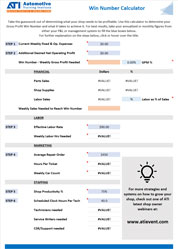Economics 101! Believe it or not, small businesses are 43.5 percent of the US gross domestic product, with 2 percent within the automotive repair industry ($277B). This means we are a part of local, national, and global economics. Somewhere in between, here is the perfect financial and production (F&P) measurement platform for you and your business.
This is not a step-by-step beginning or an advanced blueprint for your financial and production measurements and management. My hope is to set ablaze your thoughts and self-analysis on what you are currently utilizing to manage your F&P and open insight and possibilities.
Traditional checkbook accounting isn’t enough
A business checkbook is essentially a business vacuum report. It is comprehensive and offers a ton of great tools to help your business, a singular monitoring report for the pennies — a wonderful visual identification of what money is flowing through the business. That is it!
Yes, some small businesses have survived on a checkbook operational analysis basis. Survived being the operative word — I am not condoning this. For a complete understanding of your business for long-term growth or sustainability, we must do more. We must monitor and track key performance indicators (KPIs).
Five basic KPIs we must understand
Sales. Where are your sales: labor, parts, materials, sublet? Then identify the type of labor, parts, and materials. Are your sales points profitable? Here’s an analysis:
- Labor: Employee costs, including tax and benefit considerations and current margins
- Parts: What are your discounts and current margins?
- Materials: What are your discounts/markup percentage and current margins (waste management)?
- Sublet: What are your discounts/markup percentage and current margins?
Cost of goods. I am using the cost of goods and not the cost of goods sold because most of our collision industry does not charge for related needs to process the product. Solid waste removal, booth heating cycle times, fluid leak cleanup, care, custody, and protection of the vehicle while not under repair. Anything a shop must do related to the repair process that you would otherwise not have to do if that vehicle was not there is a chargeable opportunity.
Expenses. A regular review of your taxes, building, rent, lease, utilities, maintenance, equipment/tools, and purchases
Gross profit. The basic balance after you deduct the COGS from the sales.
Net profit. The basic balance after you deduct the expenses from the GP.
How to analyze labor and parts
Do you know your local and national average labor rates, parts and material discounts, and GP and NP statistics? Do you know what your highest profitability buckets are? The traditional checkbook gives us two pieces of a multi-focal jigsaw puzzle: sales and net profit for a single moment. We need much more to realize the amazing picture of financial independence we can achieve.
Labor
- Your sales point per hour per segment
- Direct costs. What you pay the technician in hourly, salary, and/or flat rate base costs.
- Your tax and benefit load. Your tax costs, workman’s compensation, time off (PTO), sick time, state-mandated time, nationally recognized holidays (Christmas, Labor Day, July 4, etc.), 401 (k) contributions, bonuses, etc.
- Your profit margin per labor segment per technician? How many billed hours do you get from each technician?
Parts
- What are your profit margins in each parts segment?
- Direct costs. What is your wholesale cost to the listed price?
- What is your desired margin? What discount are you getting in each segment?
Use a good management system
A basic profit & loss statement will provide some insight but, again, not enough. A chart of accounts is the optimum objective, but a good management system is necessary. Some management systems to consider are Shopmonkey, Tekmetric, QuickBooks, CCC One, and ALLDATA.
For a smaller collision center, even a fundamental manual tracking system can be installed while you generate increases in revenue from your findings and plan and budget for a management system. The consistent theme here is an analysis and identification of where and how you are actually making money and or where it is leaking.
Utilize and manage a full analysis
Conducting a full analysis is not just for opportunities; it will also provide you with a picture of successes. Business financial and production analysis gives you insight into what is working for the moment. Then you need to drill into the reasons for the success to see if what you are/were doing is repeatable and ultimately sustainable. A checkbook alone can’t provide you with what, where, why, how, and when behind the checkbook data.
For example, let’s say I have $12.75 in profit after using a traditional checkbook. This alone won’t cover my expenses. My profit percentages get distributed: 10 percent for the new alloy rivet gun I want, 15 percent for my shop’s roof repair, 5 percent for upgrades to the office equipment, 20 percent to buy a shop truck, 5 percent for employee raises, and 45 percent for savings.
You don’t know what expenses tomorrow will bring. KPIs from the analysis in your F&P will provide you with trends and the ability to predict production and profits to be able to move profits into multiple areas for future needs and known expenses.
You may have had a grandparent that had cookie jars they put cash into and labeled “rent,” “clothing,” “groceries,” “holiday,” and “Richard’s treats” — that was my favorite. The point here is that you can use the same “cookie jar” philosophy in all areas of your business.
Start implementing little steps toward a holistic understanding of your business and revenue. Removing the guesswork will allow you to maximize your retention and develop growth, and work toward the financial future of your business.



